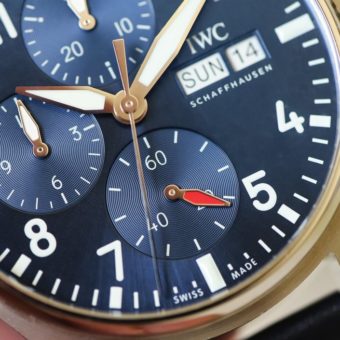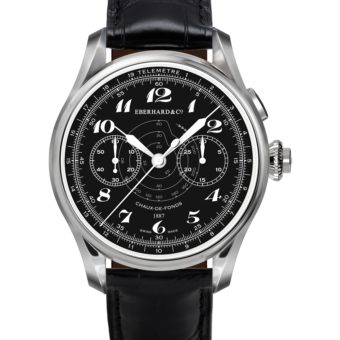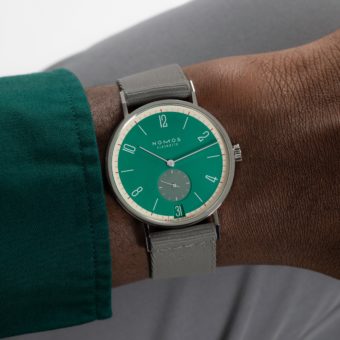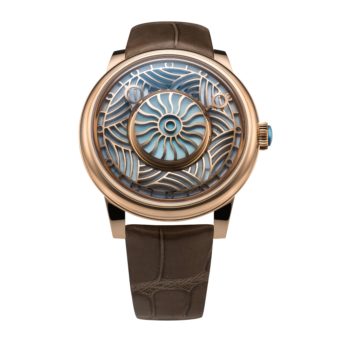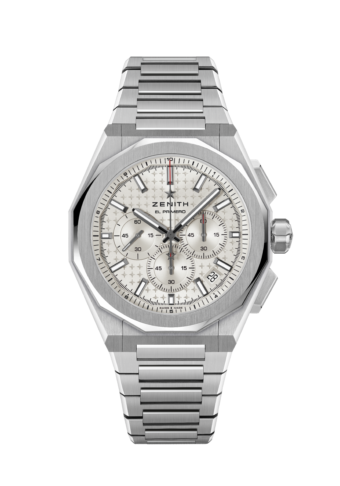The Eberhard Chrono 4 Geant’s most noteworthy feature is the layout of its chronograph counters. How well do they, and it, work? Find out in our in-depth review of the Eberhard & Co. Chrono 4 Geant.
The number “4” in the name of this watch refers to the unusual arrangement of its four subdials. On most chronographs, subdials are placed at 3, 6 and 9 o’clock (or 6, 9 and 12) – so a horizontal row of four of them right below the midline of the dial is both unusual and eye-catching. Eberhard & Co. devised this singular display based on the ETA 2894 caliber and had it patented more than 10 years ago. It was the only one of its type at the time and has since become an Eberhard & Co. trademark.
This version of the Chrono 4, which has a titanium case, was launched in 2011 in honor of the Chrono 4’s 10th anniversary. It was manufactured in a limited edition of 1,887 pieces, a nod to the founding year of Eberhard & Co.

The case of the Geant measures an impressive 46 mm across (in contrast to the 40-mm diameter of the basic Chrono 4 model) and is 14 mm thick. Rather than traditional chronograph pushers, the watch has cylindrical ones with screw-down elements. The crown, which is 8 mm in diameter and flanked by crown guards, also screws into the case. The crown screws in and out smoothly and easily but the chrono pushers don’t. They are difficult to grasp and turn. If the wearer wishes to use the chronograph function often he would do well to leave the pushers unscrewed – doing so doesn’t detract from the watch’s appearance. But he must be sure to screw the pushers and the crown into the case before exposing the watch to water. If he does so, the watch will be water resistant to 200 meters, a level adequate for diving. The caseback, which is solid and held in place with eight screws, keeps the case tight as a drum.
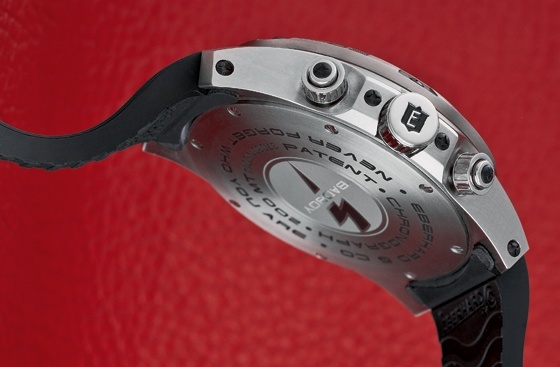
The watch has a unidirectional bezel that ratchets in half-minute increments. The bezel has a standard minutes track and a very prominent triangle at the top. The dial has a generous amount of luminous material, which makes the watch very easy to read at night – sometimes, in fact, easier than during the day.
The dial is beautifully designed. The applied metal disk toward the center of the dial is decorated with Geneva stripes and the four subdials have a fine guilloché finish, as does the dial’s outermost section. The screws that attach the applied metal disk to the dial have a PVD finish. (Similar screws appear on the bezel, crown guard and lugs.)
But the dial does have its drawbacks. Despite the applied luminous markers (which appear white under bright conditions) and the sword-shaped skeletonized steel hands, the time is sometimes unreadable even with the anti-glare sapphire crystal. Perhaps this is due to the many reflective surfaces on the anthracite ring, secured with six black screws. The brand logo is in scribed in red near the “6” and a date aperture is located at the “12.” Unfortunately, the magnifier above the date does not help with legibility because the chronograph seconds hand blocks the date when the hand is at rest at the 12 o’clock position, as it nearly always is.
Starting the chronograph requires a bit of force. The first time you push the chrono button you might think the screw-lock hasn’t been released properly, but later you’ll get used to the stiffness and see it as a sign of security. The pusher at 4 o’clock, used to reset the chronograph to zero, operates more smoothly. Unfortunately, the thin, red chrono seconds hand, although adequate in length, is difficult to locate above the dark gray dial. The seconds track is delicately executed. The four markers between each seconds marker do not correspond to the four-hertz rhythm of the balance – an oversight that is hard to excuse for an established chronograph specialist like Eberhard. And we spotted the tachymeter scale only after a second look. The overly steep angle of the inner flange at the outer edge of the dial also restricts legibility.

And what’s true for the large red hand also applies to the four small hands on the horizontal line of subdials. The small seconds hand located on the far right can be used to verify that the watch is running. It is visible in the dark due to a small bit of luminous matter on its tip. But reading the seconds precisely might require the assistance of a loupe or other magnifier. The other three subdials, from left to right, the 30-minute and 12-hour counters and the 24-hour display, can also be hard to read with the unaided eye. Anyone who puts a great premium on functionality would be better off with the classic Chrono 4 or Grande Taille model (a 43-mm version of the Chrono 4) with a black dial, white counters and white tachymeter track. These models have considerably better legibility than the Geant Titan, but they don’t have the charm of being a limited edition.
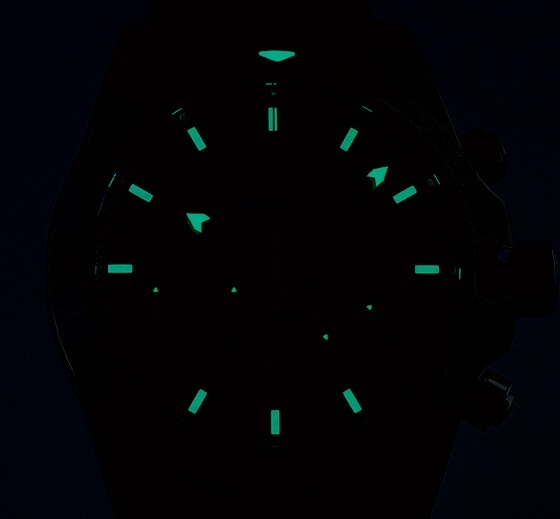
The watch’s rate results, as shown by our timing machine, were so-so. When fully wound the watch gained 7.6 seconds per day. With the chronograph switched on, it gained 6.6 seconds per day. After running for a full day, the watch gained 7.0 seconds. On the wrist, the watch showed a slightly better rate, at +5.8 seconds.
The watch has a sculpted rubber strap, held by curved lugs in a specially designed recess in the mid-section of the case. The strap has a pronged buckle made of polished titanium. The watch is also available with a titanium bracelet.
SPECS
Manufacturer: Astor Time Ltd., Vicolo Nassetta 2, 6900 Lugano, Switzerland
Reference number: 37060 Functions: Hours, minutes, small seconds; date, chronograph with 30-minute and 12-hour counters; 24-hour display; tachymeter scale
Movement: EB 251 automatic chronograph based on an ETA 2894; chonograph module patented by Eberhard; 28,800 vph; 53 jewels; Incabloc shock protection; flat Nivarox hairspring; 47-hour power reserve; diameter = 28.0 mm; height = 6.10 mm; perlage and satin finishes
Case: Titanium; sapphire crystal with nonreflective coating; solid caseback; water resistant to 200 meters
Strap and clasp: Rubber strap with pronged titanium buckle
Rate test: (Deviations in seconds per 24 hours, when fully wound/after 24 hours)
Dial up +8.5 / +7.2
Dial down +9.1 / +8.0
Crown up +5.9 / +5.0
Crown down +4.5 / +4.7
Crown left +10.2 / +9.9
Greatest deviation of rate 5.7 / 5.2
Average deviation +7.6 / +7.0
Average amplitude:
Flat positions 337° / 280°
Hanging positions 292° / 252°
Dimensions: Diameter = 46 mm, height = 14.1 mm
Price: $10,600 ($11,530 with titanium bracelet)
PROS:
+ Patented chronograph module
+ Attractive design
+ Good nighttime legibility
CONS:
– Poor daytime legibility
– Screw-down locks for chronograph pushers are hard to use.
This article originally appeared in the April 2013 issue of WatchTime magazine. Original photos by Zuckerfabrik Fotodesign.


